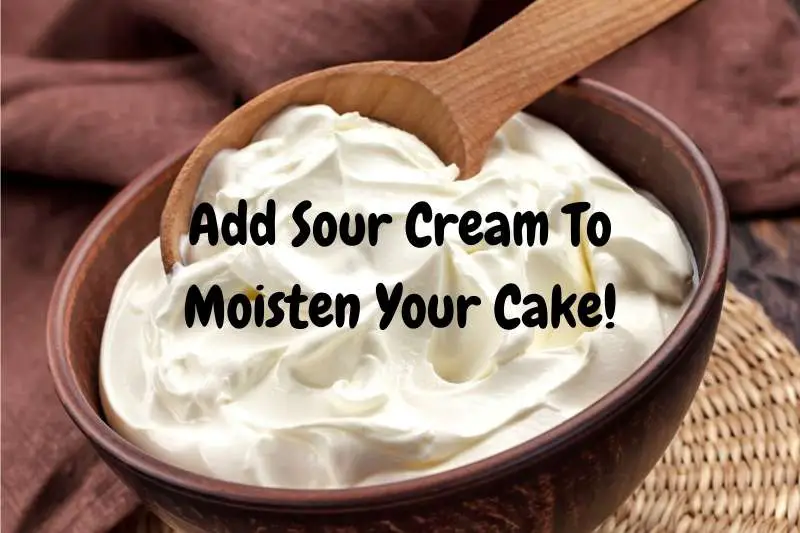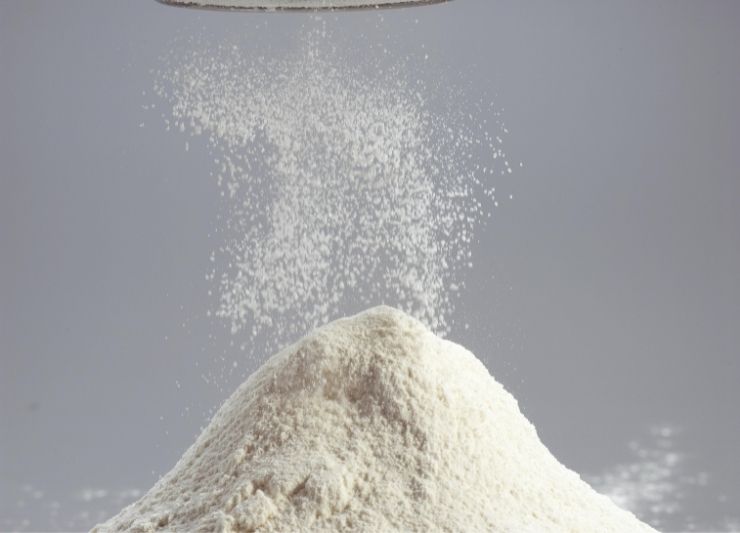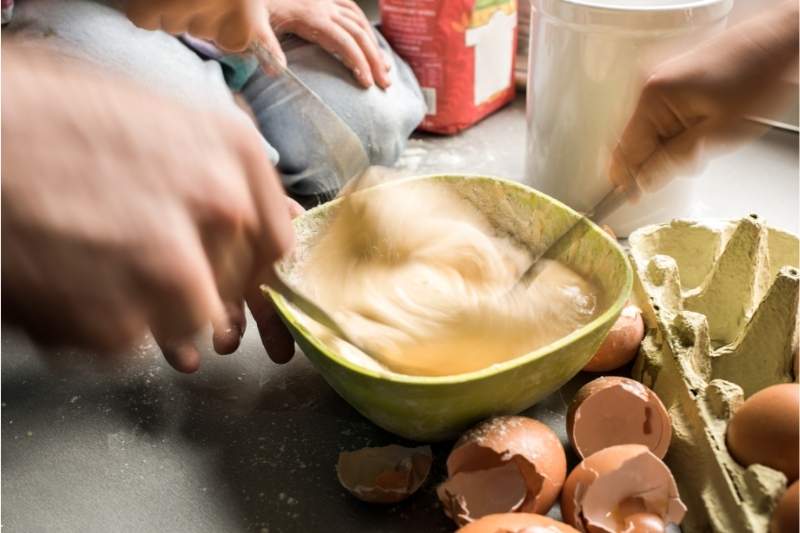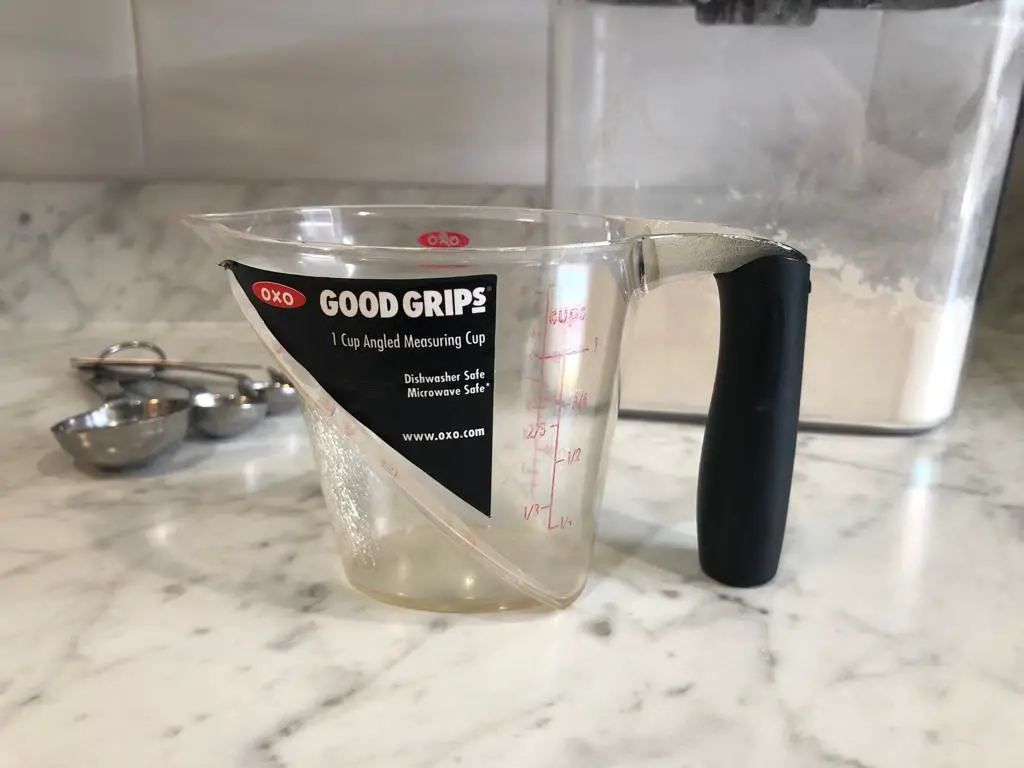This post contains affiliate links.
In the past, whenever my cakes went wrong, it was either because they were too heavy and dense or because they were too dry, and at first, I was often unsure of where I specifically went wrong in the baking process to cause those issues.
Why is My Cake so Dense and Heavy?
Generally speaking, your cake is dense because you made a mistake when preparing your cake batter. Common mistakes include using cold ingredients or over-mixing your batter. Additionally, not measuring your ingredients properly can cause them to be too dense or heavy.
I’ve always enjoyed cooking as well as baking, and when I first began making cakes, I incorrectly assumed that I could approach baking in the same way that I approach cooking.
Not fully measuring ingredients, changing recipes on a whim, and following my “gut,” were all things I did when I first began making cakes because that’s how I often cook.
Unfortunately, these actions went against the scientific needs of baking and often led to many disastrous cakes.
While these ruined cakes were frustrating at the time, I’m thankful for all of those blunders because now I can share with you what you can do to prevent making the same mistakes I did and how you can fix them if you do.
*Side Note: You might also want to know why your cakes can sometimes come out Crumbly or Moist. I dug into the root of the problem and I wrote an article about Preventing and Fixing Crumbly and Moist Cakes, which you can check out here!
9 Ways to Fix & Prevent Dense Cakes
- Add Sour Cream
- Use Cake Flour
- Add Leavening Agents
- Use Room Temperature Ingredients
- Don’t Over-Mix The Batter
- Make Single Recipes
- Monitor It Properly
- Add Oil
- Use Correct Measurements
I love to bake, and cakes are my favorite thing to make. Whenever a friend or family member has a birthday, I am the designated cake maker. Because of this, I have had a lot of experience making cakes and have thus had the opportunity to learn from many mistakes over the years.
While I like to do my mixing by hand, I much rather prefer using a Stand Mixer instead. I recently wrote an article that talks about the 3 Best Stand Mixers that bakers can buy in each stage of their baking journey. After reviewing a few stand mixers, the Best Overall Mixer was the KitchenAid Artisan Tilt-Head Stand Mixer. You can check out this stand mixer on Amazon!
1. Add Sour Cream
Generally speaking, adding sour cream to your cake batter is a great way to prevent making a dense or dry cake. While many people have learned to incorporate dairy into their recipes, sour cream is often left out even though this ingredient can add much-needed moisture to any cake batter.
I actually came to learn about the moisture benefits of sour cream when I was once making a homemade chicken pot pie for the first time.

While making that chicken pot pie, I accidentally made the rookie mistake of adding in a little too much flour when making my roux, and I needed to add in an ingredient that would add moisture to my filling without sacrificing the thickness I desired.
That’s when I came across a recipe that recommended using sour cream along with milk and broth to make the cream filling for chicken pot pies.
Remembering how well the sour cream worked in my pot pie recipe attempt, I then decided on a whim to add it to a cake batter that I was having trouble with, and to my amazement, the sour cream added both moisture and a lightness to my batter that I came to love.
To make your cakes more moisturized with this ingredient and prevent them from becoming dense, I recommend adding in one or two tablespoons of sour cream.
Plain yogurt can work as well, and neither ingredient will noticeably alter the taste of your cake, but will greatly improve its moisture in my experience.
2. Use Cake Flour
Since cake flour has a finer consistency, using it instead of all-purpose flour can help prevent your cakes from becoming too heavy or dense. However, you cannot use cake flour for every cake recipe as it is sometimes too fine to support some recipes.
Cake flour has less protein than other types of flour including all-purpose flour. It is also milled to a finer consistency. These traits make it an ideal flour to use when you want to light and fluffy cakes.
You can use cake flour to make vanilla, red velvet, or white cakes and cupcakes.

*By the way, I recently wrote an article about How to Aerate & Measure Flour The Right Way. This article talks about all the things you need to know to make sure you properly use flour when baking. You can check out this article here!
Chocolate cakes, however, are best made with all-purpose flour as the fine consistency of cake flour plus the softer consistency of cocoa powder leads to unstable cakes when used in combination.
The ratio for substituting in cake flour for all-purpose flour is 1:1, so if a recipe calls for three cups of all-purpose flour, then use three cups of cake flour.
3. Add Leavening Agents
Generally speaking, adding baking powder and baking soda can help prevent a dense cake when making some recipes. For cakes with more acidity, like lemon cakes, adding in some baking soda can lessen the acidity while the addition of baking powder can provide lift and make the cake fluffier.
Because baking soda and baking powder can affect the taste of your cake, it’s important to be careful when adding them to your recipe.
You typically should use about 1/4 teaspoon of baking soda and 1 teaspoon of baking powder for every cup of flour in your recipe, respectively.
*By the way, you might also want to know If Cornstarch Can Replace Baking Powder. I recently wrote an article about Baking Powder Substitutes That Work, you can check it out here!
4. Use Room Temperature Ingredients
Generally speaking, it’s important to use room-temperature ingredients when making your cake batter so that it can prevent you from creating a dense cake. Room temperature ingredients are easier to incorporate into your batter, and this means you’ll be less likely to over or under-mix them.
Most cake recipes require you to cream butter and sugar together or mix in eggs or other wet ingredients. Room temperature ingredients are better able to bond to other ingredients, so when you cream or mix them, the process to do so takes less time and effort.
Since you have to spend less time creaming or mixing in ingredients that have reached room temperature, you’re then less likely to over-mix your batter.
Since the over-mixed batter is one of the most common causes for dense cakes, if you’re able to avoid doing that because you’re using room-temperature ingredients, then you’re also more likely to avoid making a dense cake overall.
5. Don’t Over-Mix the Batter
When you over-mix your cake batter, you’re making it so your cake will be heavier and denser when you bake it. Overmixed batter will have too much air incorporated into it which will tend to escape the cake during the baking process. Make sure to mix only until the ingredients dissolve.
While mixing ingredients by hand can often lead to under-mixing ingredients, using a stand or hand mixer, as is common with bakers, can just as easily lead to over-mixing ingredients.

*By the way, I recently wrote an article about How To Bake A Cake Without An Oven. In this article, I mention different ways of baking a cake if you don’t have an oven around. You can check out this article here!
To avoid over-mixing your ingredients, be sure to only mix them until your ingredients are just combined. A batter that is mixed properly shouldn’t have any noticeable lumps at the bottom of the bowl or any ingredients that aren’t fully blended in.
You can quickly go from having a batter that’s mixed purposefully to having one that’s over-mixed if you aren’t paying attention.
If you have some noticeably unblended ingredients like flour still in your bowl, then you can use a whisk to blend those ingredients by hand until they’re mixed in.
I do not recommend continuing to use your electric mixer at that point as you can quickly end up overmixing your batter because you’re trying to blend in a few bits of flour.
*By the way, you might also want to know How To Mix Batter Without a Mixer. I recently wrote an article talking about The Right Ways of Mixing Batter By Hand, which you can check out here!
6. Make Single Recipes
Generally speaking, one way you can avoid making a failed dense cake is by not doubling or otherwise changing the measurements of your recipe. When baking for large gatherings, do not double or triple your recipe since it will cause your cake to become heavy.
If you need to double or more your recipe, I recommend using separate bowls and baking tins.
If you double your recipe and only make one batter, then you’re going to be more likely to either over-mix your batter or have ingredients in your batter that aren’t fully blended in.
In the case of ingredients like baking powder or baking soda that can affect the taste of your cake, you can then yield disastrous results that go beyond just making a dense cake.
Additionally, adding too much batter to your baking dishes because you’ve doubled or more your recipe can lead to your cake not baking properly and you can have a cake that’s over-baked and dry on the outside but dense and under-baked inside.
7. Monitor it Properly
In general, you can help prevent your cake from becoming too dense by monitoring it properly while it is baking. To do so, I recommend keeping track of how long your cake is baking and making sure to avoid opening your oven until doing so is necessary.
Even if you make your cake batter properly, you can still hinder the success of your cake if you drop the ball while it is baking.
Here are a few things you can do to help ensure the success of your cake while it is baking:
- Keep track of how long it’s been baking and checking on it within one to two minutes of its estimated ready-time
- Not opening the oven door until you have to in order to prevent its temperature from dropping
- Use a knife or a toothpick to check that your cake is done.
*Side Note: If you want to learn How To Bake A Cake Without Vanilla Extract, I recently wrote an article talking about the Substitutes that you can use for Vanilla Extract, which you can check out here!
8. Add Oil
Generally speaking, adding some oil to your cake batter can help give it more moisture than just butter and milk can provide alone. Adding two tablespoons of vegetable oil can make your cake moister during the baking process.
Unsweetened applesauce is a great substitute that you can use in a recipe in place of oil. If a recipe calls for half a cup of oil, you can use a quarter cup of oil along with a quarter cup of applesauce instead.
If you substitute applesauce in place of some oil, your cake will need about a quarter less time to cook, so keep that in mind to prevent over-baking your cake.
9. Use Correct Measurements
To prevent making a failed cake, it is imperative that you measure your ingredients properly. Baking is a science and is much more strict with measurements than cooking is. Make sure to follow the recipe’s ingredients ratios precisely to achieve a cake that isn’t dense.
Measuring ingredients when baking requires precision, so I recommend using a scale to weigh your ingredients rather than just relying on measuring cups.

I usually use this OXO Good Grips Angled Measuring Cup to measure out all of my dry and wet ingredients when baking. As you can see, this cup served me well over the years. You can check out this measuring cup on Amazon!
How Do You Moisten a Dense Cake?
To moisten a dense cake, you will need to include simple syrup, glaze, milk, or ice cream into your cake batter to add in more moisture. You can also steam the cake by placing it in the microwave for 30 seconds or applying frosting to make your dense cake moistened.
To add simple syrup to your cake to moisturize it just requires two ingredients in equal parts: sugar and water. You can also use a simple glaze made of icing sugar and milk or water to moisturize your cake as well.
Another way you can moisten a dense cake is by soaking it with milk or steaming it.
Finally, you can also just choose to eat your cake with ice cream or frost it well on top and between its layers to make your cake a bit more moistened while you’re eating it as well.
How Do You Make a Dense Cake More Fluffy?
Generally speaking, a dense cake that is already made is difficult to fix and make more fluffy. However, when making the recipe again, things you can do to make your cake fluffier are measuring your ingredients well and being mindful of your oven’s temperature.
As mentioned above, using a scale to weigh your ingredients can help ensure a more successful and fluffier cake when you bake it.
Additionally, making sure your cake is baking at the right temperature can help make sure it’s baked evenly and no parts are too dry or too dense.
Can You Eat Dense Cake?
Generally speaking, you can eat dense cake. You may not like the texture of your cake, but it is still edible. However, if you find the texture of your dense cake unbearable, then you can try making other recipes with it before throwing it away.
If you want to eat your failed dense cake, then you can try turning it into cake pops or using it in a trifle.
*Side Note: You might also want to know The Many Ways To Use Leftover Cake Batter and Trimmings. I recently wrote an article that talks about Creative Things To Do With Leftover Cake Batter & Trimmings, you can check out this article here!

